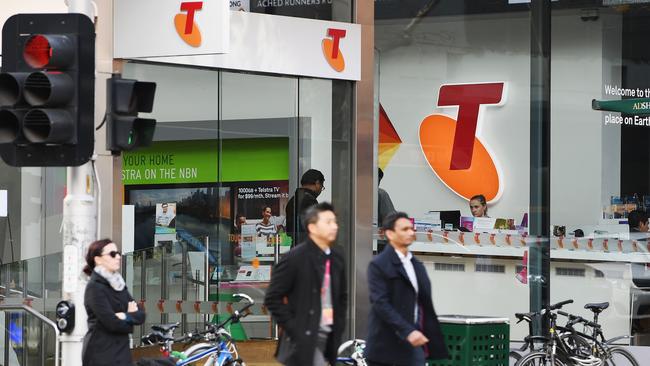Telstra shareholders face dividend cut
Telstra shares plunged over 10pc on plans to scale back dividend payouts, as it moves to lock in recurring NBN payments.

Telstra plans to scale back its popular dividend payouts and is moving to lock in recurring payments from NBN Co.
The telco today pegged its dividend forecast for fiscal 2018 to 22 cents per share, as it also took steps to monetise some of the money it’s getting from the NBN.
Telstra (TLS) also announced a new dividend policy to more closely align ordinary dividends to underlying earnings.
It has moved to reduce its payout ratio to 70-90 per cent of its underlying earnings, compared to the near 100 per cent it has handed shareholders in recent years.
It further plans to return 75 per cent of net one-off NBN receipts to shareholders over time via a special dividend.
For the coming financial year, that is expected to mean the overall dividend falls 29 per cent.
“We realise this is a material reduction from the historic level of our dividend and we do not underestimate the impact on our shareholders,” said Telstra boss Andrew Penn, who said the changes followed a review.
Telstra shares closed down 10.62 per cent at a five-year low of $3.87.
Telstra said it planned to pay a final dividend of 15.5c a share for a full-year payout of 31 cents. Half-yearly payments have now remained steady at 15.5 cents five periods running, but for the year ahead the company said it expected a full-year dividend of 22 cents.
“We have consulted extensively with shareholders and other stakeholders during this review and the overwhelming and consistent feedback from this consultation process has been to ensure we are planning for the longer term, and retaining financial flexibility,” Mr Penn said.
Mr Penn said that the new dividend policy, which will start after the final dividend for fiscal 2017 is paid, was the best way forward for Telstra to maintain its balance sheet and flexibility as the NBN transition gathers pace.
“From FY18 we will adopt an ordinary dividend payout ratio of 70-90 per cent of underlying earnings, which is more in line with global peers and local large companies,” he said.
Mr Penn added that the special NBN dividend will ensure that Telstra shareholders get a benefit from the NBN process.
“We believe this is appropriate given one-off income is akin to compensation for an asset sale over a number of years and aligns with market feedback and expectations that these receipts are returned to shareholders,” he said.
As part of its capital allocation program, Telstra is also mulling plans to lock in 40 per cent of the cash it’s getting from the government to relinquish its wholesale monopoly.
Mr Penn warned that the potential monetisation process was subject to a number of conditions. However there were significant benefits.
“The scale of the proposed transaction is approximately $5 billion − $5.5bn, with Telstra to retain some equity interest,” he said.
According to Telstra, the move will not impact it’s A band credit rating.
“Our intention would be to use the proceeds to reduce debt by around $1 billion, with the balance to support a capital management program to enhance shareholder returns, most likely through a series of on and off market buy-backs,” Mr Penn said.
The results of the capital allocation review carried came as Telstra posted a slight jump in its underlying net profit for fiscal 2017 to $3.9 billion.
Australia’s largest telco booked a reduced full-year profit in FY17 of $3.89 billion compared to $5.85 billion the year previous.
However, net profit after tax from continuing and discontinuing operations slumped 33.8 per cent to $3.9 billion, with Telstra citing the absence of one-off sugar hit from the $1.8bn sale of Autohome shares in fiscal 2016 as the main reason for the drop.
Revenue for the year was 2.7 per cent lower at $26.01 billion from $26.74 billion.
In mid-June, Telstra moved to cut up to 1,400 jobs by the end of 2017 as it grapples with intensifying competition, new technologies and an up to $3 billion earnings shortfall as the National Broadband Network switches on around the country.
A year ago, Telstra launched a $3 billion investment to upgrade its networks over three years as part of efforts to attract and retain customers. As the NBN network rolls out, Telstra is gradually being stripped of its wholesale infrastructure monopoly. It agreed to sell its fixed-line infrastructure to the federal government for $11 billion to help build the NBN.
International rivals including Vodafone Group and Singapore Telecommunications Ltd’s Optus unit have been pushing hard for market share in the mobile market by upgrading their networks and boosting the attractiveness of their plans.
Telstra also faces competition from a new domestic rival, after TPG Telecom said it would invest $1.26 billion on a new mobile network that would be aggressively priced.
Still, despite the changes in the market Telstra said it continued to grow its customer base across important sectors, with retail mobile adding 218,000 customers, and its number of NBN connections rising by 676,000 to bring its overall share of the market to 52 per cent.
Costs have also fallen, and it now plans to accelerate its efforts and save $1 billion in the 2020 financial year, one year sooner.
With Dow Jones Newswires



To join the conversation, please log in. Don't have an account? Register
Join the conversation, you are commenting as Logout